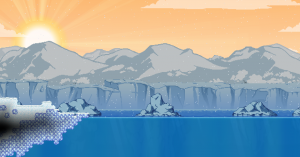Arctic
| Threat: Extreme (Tier 5) | Weather | |
| Star types: Frozen, Fiery | ||
| EPP Required: | ||
| Mini Biomes: None | ||
| Secondary Biomes: None | ||
Arctic planets can be found orbiting frozen (blue) and fiery (red) star types. Unless players have an Heating EPP Upgrade equipped they'll perpetually take damage from deadly chill while on the planet.
The ocean found on arctic planets is infinite, and cannot be drained. All air below surface level is replaced with water. To build underwater and not have water spawn inside your structure, you must replace the background and foreground with blocks, then remove the foreground blocks and water will stop spawning.
Capricoat, Lilodon, Monopus, Pulpin, Skimbus, and Wisper all have a chance of being found in arctic biomes.
- Temperatures at the landing site are dangerously low. You will be beaming onto a small island surrounded by frigid ocean. I strongly advise you to wear a scarf.
- The beam site is intensely cold: a tiny island in a frigid ocean. There is a 0.025% chance you will mis-beam into the water, quickly succumbing to the awful chill.
- A site of dangerously low temperatures. There are few animals here, and no plant-life at all - just forsaken islands in a frigid ocean.
Materials
The surface layer of arctic planets is primarily made up of water ocean with small scattered islands made from ice and slush. There are almost no natural resources on the surface of these islands.
Arctic planets are mostly covered in water which spawns endlessly. There's no way to gather all of the water found in arctic oceans.
Ores can be found on surface islands, with of copper, silver ore, gold and durasteel available in small quantities. Most ore is accessible beneath the ocean floor.
| Primary material | Sub materials | Geological materials | ||
|---|---|---|---|---|
Music Tracks
Arctic surface biomes use their own sets of music tracks for day and night.
|
|
Arctic ocean floor biomes use the Day Tracks plus both Arctic Exploration tracks during the day and the Night Tracks during the night.
|
|
Sub Biomes
Arctic planets do not have any sub biomes which appear, and arctic oceans do not appear as a sub biome on any other planet types.
Mini Biomes
There are no mini-biomes found on the surface or underwater in arctic biomes.
Layers
Arctic planets deviate somewhat from planetary standards due to being ocean-type planets.
- Space: Asteroids
- Atmosphere: Atmosphere
- Surface: Arctic (Primary Biome)
- Note: For ocean-type planets, the surface layer begins at y=1050 and the ocean surface is at y=1150 regardless of planet size.
- Subsurface: Arctic Ocean Floor
- Shallow Underground: Tarpit, Mushrooms, Wilderness, Mini Village, Underground 0a, Underground 0b, Underground 1a, or Underground 1b
- Mid Underground: Luminous Caves, Stone Caves, Bone Caves, Ice Caves, Underground 0c, Underground 1c, Underground 1d, Underground 3a, Underground 3b, Underground 3c, or Underground 3d
- Deep Underground: Cell Caves, Flesh Caves, Slime Caves, Underground 0d, Underground 5a, Underground 5b, Underground 5c, or Underground 5d
- Core: Blaststone Core Layer, Magmarock Core Layer, or Obsidian Core Layer
Weather
Weather in arctic biomes is either snow, blizzard or clear. Weather happens for each planet based on the weights given to the weather types (probability is calculated by dividing a single weight by the sum of all weights); the probability for weather types on arctic planets is as follows:
| 0.5 | (50%) | |
| 0.3 | (30%) | |
| 0.2 | (20%) |
Wild Crops
There are no wild crops unique to arctic planets, and since there are no mini or sub biomes there's no chance of finding any crops of any kind on the surface.
Wildlife
In addition to procedurally generated creatures, there are a variety of unique monsters, bugs and critters found in arctic biomes. Some of these are also found in other biomes, while others are unique only to arctic biomes. While these unique creatures have a chance to appear on arctic planets, they will not all appear on each one. In addition to unique creatures, each biome has multiple types of both procedural ground and flying creatures.
Unique monsters each have combat attacks, and they must first be weakened before capture. Once weakened players can attempt to capture using a capture pod. If successful they can then be released to battle alongside and follow the player.
Critters are smaller non-combat unique creatures which are not capturable using capture pods. They can be captured without weakening them first by using a relocator gun. After releasing a critter from the relocator it will stay in the area it was released into.
Bugs are very small unique creatures which can be captured using a bug net, and are then stored inside placeable jars. Bugs which are captured using a relocator will fly after release instead of being kept inside a jar.
|
|
| ||||||||||||||||||||||||||||||||||||||||||||
Fishing
There are a number of fish which can only be caught on arctic planets using a Fishing Rod. These fish won't be seen swimming in the wild without a fishing lure to attract them.
Catching each of these fish will complete their entries in the fishing collection screen.
| # | Image | Name | Size | Rarity | Biome | Description | Behavior | Depth | Time |
|---|---|---|---|---|---|---|---|---|---|
| 25 | Arctic Speartooth | Small | Common | Arctic | It maintains a hard icy shell around its body for protection. | Approach | All | All | |
| 26 | Salt Rampskull | Small | Common | Arctic | It polishes the diagonal crest in its head against rocks and coral reefs. | Approach | Deep | All | |
| 27 | Blue Sabertrout | Small | Common | Arctic | Can be trained to harvest ice cubes with its tiny, sharp front teeth. | Lurk | Shallow | All | |
| 28 | Sealacanth | Large | Uncommon | Arctic | Nearly identical to its prehistoric ancestors, but more blubbery. | Approach | Shallow | All | |
| 29 | Whiskered Chub | Medium | Uncommon | Arctic | Its long, drooping whiskers grow continually. They can eventually exceed the length of its body. | Lurk | All | All | |
| 30 | Coral Chirpfish | Small | Uncommon | Arctic | It chirps when it's happy. Does it think it's a bird? | Approach | All | Day | |
| 31 | Glacial Wimp | Small | Uncommon | Arctic | It spends much of its time avoiding predators by scurrying away with its tiny legs. | Approach | Deep | Night | |
| 32 | Luminous Swindler | Small | Rare | Arctic | Lures in prey with its shiny head bobble. Infamous among fish for being a bit of a jerk. | Lurk | Deep | Night | |
| 33 | Garland Conger | Medium | Rare | Arctic | Multiple swim bladders along its body give it fine control of its buoyancy. | Approach | All | All | |
| 34 | Right Gazer | Medium | Rare | Arctic | Its huge eyes help compensate for distortion caused by differing water temperature and salinity. | Approach | Shallow | Day | |
| 35 | Muckfang | Medium | Rare | Arctic | This slow moving amphibian can spend hours approaching prey before paralysing them with venomous fangs. | Approach | All | All | |
| 36 | Variegated Breacher | Large | Legendary | Arctic | A strong fish that uses its robust horn to break through thick sheets of ice. | Approach | Deep | All |
Unique Drops
There are no drops unique to arctic planets.
Settlements
There are no villages or dungeons found on arctic planets, they're too harsh to support any type of settlements.
|
Screenshots
| Biomes | ||||||||||
|---|---|---|---|---|---|---|---|---|---|---|
| ||||||||||










